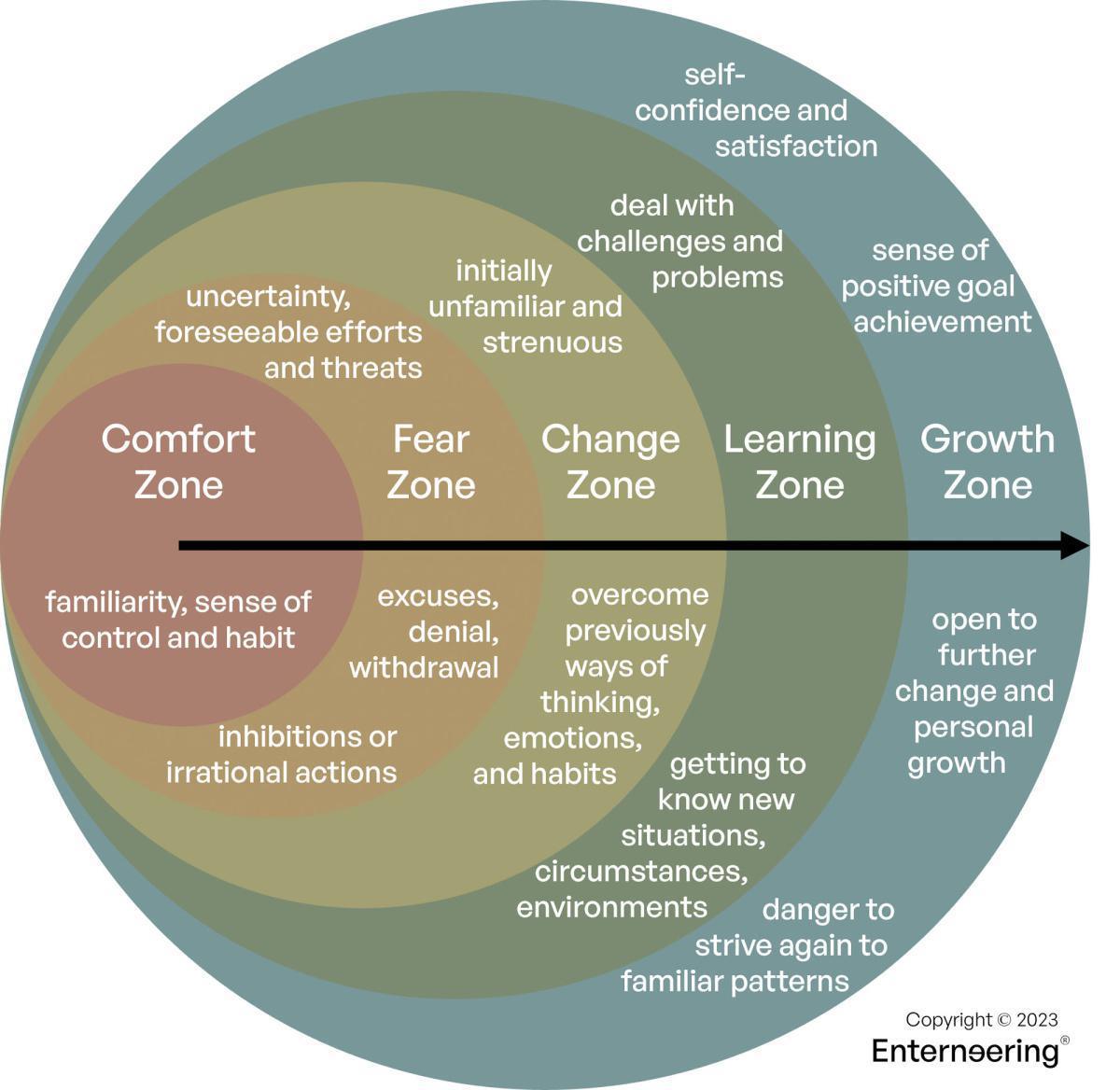The way to an above-average increase in success is through significant changes. Those who set high success goals for their personal development should always expect to make a considerable investment in personal transformation. This also applies to personal success in the effective application of Enterneering®. Those who have not succeeded in implementing effective Enterneering® within themselves and their personal environment with their previous habitats and behavioural patterns will not succeed without considerable changes, even with the very best of intentions. Managing such changes means that you must conquer yourself and your own comfort zone. It’s important to note that remaining in a familiar environment does not necessarily equate to being inevitably unsuccessful or unhappy, since success is always a matter of individual definition. If one follows the 'comfort zone model', one must move out of one's familiar environment and leave entrenched structures in order to develop further. How do people with a high level of responsibility for the further development and change of others or organisations want to be successful if they do not succeed in taking their own step out of their comfort zone?
What
What does 'comfort zone' actually mean? How can this state be identified and under what conditions does it arise? It can be assumed that every person has his or her comfort zone and usually strives to occupy and maintain it. The comfort zone is marked by traditions, familiar patterns, ingrained routines, and situations with little uncertainty. The comfort zone is thus the diametrical opposite of change. Through its familiarity and compatibility with personal inclinations, it provides people with a sense of security and sovereignty. It is probably even a component of the human survival strategy.
| People tend to be afraid of change. Staying in your comfort zone means knowing what you have and what to expect. |
Comfort zones are unique to each individual. They are shaped by a person's personality, values, and experiences. People react very differently to certain situations. What triggers panic in one person may not be a problem for another and is therefore still within their comfort zone. That is why it is very useful to know the limits of your comfort zone. The following zone model has been defined for an effective discussion on this topic. It describes state ranges or transitions between individual comfort levels. Each of these levels or zones can be attributed to certain characteristics.
| COMFORT ZONE |
|
FEAR ZONE |
|
CHANGE ZONE |
|
LEARNING ZONE |
|
GROWTH or DANGER ZONE |
Leaving one's comfort zone means overcoming personal fears. One should neither underestimate this nor believe that one does not have fears. Every person carries certain fears or inhibitions. Not everyone would label these characteristics as fears or personal inhibitions and yet in many cases the effect is identical. Those who reflect self-critically will realise that it is often the excuses and the procrastination of efforts that mark the reaching of the limits of the comfort zone.
Fear of wrong decisions, risks, and failure
This form of fear acts as a limitation in personal development. Anyone who aspires to increase their success significantly or beyond a known level must overcome this fear. Hardly any business decision is free of risks or errors. Without mistakes, learning according to the cause-effect principle is hardly possible and only where there are risks, there are usually also chances for significant increases in success. Trying to achieve one without doing the other is unlikely to yield success.
Fear of increased effort and strain
The word fear can also be replaced with timidity here and still the result would be the same. In the corporate world, there is often a fear of supposedly additional effort, which superficially does not make an immediate quantitative contribution to the desired result. As a result, such efforts are often postponed to a later, more suitable point in time. It can usually be observed here that solid arguments are quickly listed that justify such a postponement. It can be considered a personal strength if one recognises this pattern and consciously confronts it.
Fear of rejection and disappointment
Who does not know the feeling when one's own idea, of which one is absolutely convinced, does not reach the target group or is even actively rejected? Many entrepreneurs know this feeling all too well in business life. Nevertheless, this should not be a plausible reason to not follow one's convictions or refrain from pursuing ideas, expectations, or objectives. People who never experience difficulties in their lives or are recognised and liked by everyone are like roundly polished pebbles at the bottom of the river. They can never change the direction of the river or significantly influence its force.
Stepping out of the comfort zone takes on added significance when implementing Enterneering®. On the one hand, many people with corporate responsibility must leave their personal comfort zone in order to act authentically and effectively in Enterneering®. On the other hand, they often need to move parts of the business organisation or the entire organisation out of their comfort zone. Entrepreneurs and executives must also be familiar with this topic in the context of change management in order to be successful in both.
How
The golden rule is: If you want to consciously move out of your comfort zone, you should always start with small steps. Smaller steps not only protect against serious frustration but also allow for more effective correction or adjustment during development. Following the zone model outlined above, it is important to aim for smooth transitions between the individual zones rather than attempting to master big leaps. One should leave one's comfort zone slowly and consciously and get used to the unfamiliar conditions and the associated uncertainty. It is also crucial to realise that the goal is not to change the comfort zone, but rather to foster continuous improvement. It is therefore important to recognise which elements are worth preserving or require continuous improvement and which require short- to medium-term change. The following approaches have proven helpful on this path:
| Developing self-motivation |
|
Ignoring the interference |
|
Visualising motives and goals |
|
Changing basic patterns |
|
Changing work habits |
|
Engaging other people on newly defined issues |
|
Acting consistently |
|
Making change visible |
|
Knowing the consequences of failure |
|
Ensuring balance |
|
Involving companions |
Ultimately, it is not significant whether one believes in the comfort zone model or is more oriented towards the principle of the personal change curve. In essence, it is about understanding and recognising the impact of change on people and oneself. Anyone who wants to or must deal with change in an active and target-oriented way should have the necessary basic knowledge and personal skills to do so. Above all, however, the most essential qualities are willingness, perseverance to do so, readiness to face setbacks, and making adjustments.




